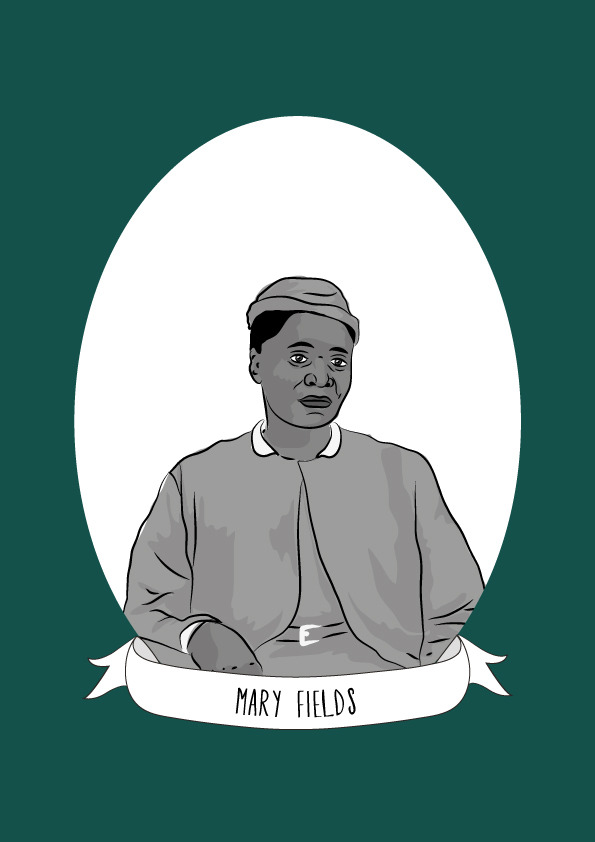Mary Fields (also known as Stagecoach Mary and Black Mary) was the first African-American woman employed as a mail carrier in the United States. She was the second woman to work for the United States Postal Service.
Fields was born a slave in Hickman County, Tennessee around 1832. When American slavery was outlawed in 1865 she became free and began work as a chambermaid on the Robert E. Lee, a Mississippi River steamboat. While working on the steamboat she met Judge Edmund Dunne and worked for a time for his family as a servant. In the 1870’s Fields began working at the Ursuline Convent in Toledo, Ohio. Dunne’s sister, Mother Mary Amadeus, was the superior. In 1884 Mother Amadeus was called to take up a position at the new St. Peter’s Convent near what was to become Cascade, Montana.
In 1885 Mother Amadeus became ill and called for Fields who nursed her back to health. Fields stayed to work at the convent and did ‘heavy work’ including hauling fright and supplies for the convent, chopping wood, completing stone work and rough carpentry and digging holes. When reserves ran low Fields was responsible for making a supply run, she handled the team that hauled the goods alone. One night in the middle of winter wolves startled her horses and her wagon overturned. Fields stood guard and single handedly protected the food from the wolves all night, delivering it safely in the morning. Fields gained a reputation for having “the temperament of a grizzly bear,” but it was well known that she was utterly devoted to the nuns and students.
In 1894 Fields was banned from the convent by Bishop Brondell because of her tendency to smoke, swear and the fact that she was heavily armed at all times (she was a crack shot with revolver and rifle) and always ready for a fight. A shoot out between Fields and a hired hand who had complained that an ‘uppity coloured woman’ earned $2 an hour more than him was the last straw. The Nuns defended her but there was nothing they could do. Fields moved into nearby Cascade where she was the only black resident. She tried and failed twice at running a restaurant due to her lack of cooking skills and the fact she’d serve anyone regardless of whether or not they could pay, leaving her broke. Mother Amadeus assisted her in securing a contract to carry the United States Mail to St. Peter’s Mission. She became only the second woman in the country to manage a mail route and the first African-American woman. She quickly earned a reputation for delivering the mail no matter the weather or route. She delivered mail through blizzards and scorching heat to reach remote miner’s cabins and outposts. Her efforts helped to advance the development of a considerable area of central Montana. She delivered mail until she was 69.
When Fields eventually gave up her mail route she made her living by taking in laundry at home. The residents of Cascade admired her and on her birthday they would close the schools in her honour. Fields would buy candy and treats for the children in return. Fields relaxed a little in her old age and frequented saloons, when Montana passed a law to forbid women entering saloons the mayor of Cascade granted her an exemption as a sign of respect. At the age of 72, Fields followed a man who owed her $2 for an unpaid laundry bill out of a local bar and punched him, knocking him flat. She announced that his bill was paid on her return to the bar. In 1912 her laundry business and her home burned down, the town responded by building her a new home. Fields supported the Cascade baseball team and prepared buttonhole bouquets of flowers for each player from her own garden. Anyone who spoke ill of the team could expect her fist in their face.
Fields rejected the traditional gender boundaries of her era, she was 6ft tall and usually had a pistol strapped under her apron and a jug of whiskey by her side. She did not marry or depend on the support of anyone but herself. She was always armed, smoke, drank, swore and took work delivering mail which was traditionally thought of as a ‘man’s job’. Due to her dependable and reliable work as a mail carrier she was undeniably influential in the the development of central Montana. After her death, she was buried in a small cemetery alongside the road between Cascade and St. Peter’s Mission that she had travelled so many times during her life.
